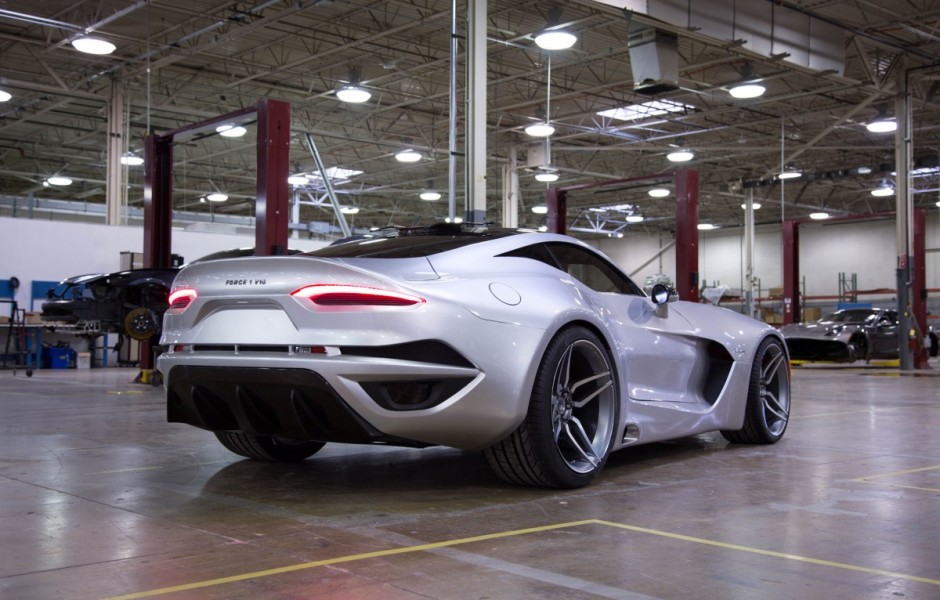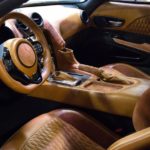Henrik Fisker has played a pivotal role in some of the most striking vehicle designs of the last several years. The BMW Z8, Aston Martin DB9 and V8 Vantage, and the Fisker Karma are all credits to his name. Though some designs have been better received than others, Fisker maintains great respect within the automotive industry.
As of late, the designer has turned his attention to new projects, including a yacht that will be co-developed with Benetti, and the Destino sports car by VLF Automotive (former GM boss Bob Lutz’s startup). Then there’s the Force 1, a Dodge Viper-based supercar that’s best described as a passion project from Fisker and Tudor Championship racing driver Ben Keating.
Though it might sound like an odd match, the collaboration was formed out of Fisker’s vision to produce an American supercar to take on the world’s best. Of course, Fisker could handle the design work, but in terms of mechanical know-how, he was referred to the expertise of Keating, who founded Viper Exchange, a Dodge Viper-exclusive dealer and performance tuner.
To learn more about how the $280,000 Force 1 was brought to life, we interviewed Fisker and Keating on the eve of the car’s production date later this month.
Miles Branman: Henrik, how did you find your way to this collaboration, to designing the Force 1?
Henrik Fisker: I saw the opportunity to create something unique, something that didn’t exist in the marketplace, and to develop it quickly. The technology that could be incorporated into this vehicle was remarkable, and the timeline to get it onto the market was so accelerated. Most automakers take three to five years to produce a new product, and we could make something low-volume, highly customized, and still very advanced in a much shorter time at a price point that is, in my mind, very reasonable compared to what’s out there. This project would be exclusive, far more so than other products costing between $200,000-$300,000.
Speaking to how quickly you were able to develop this car, what was your timeline with Ben?
Henrik Fisker: Well, we’re still fine-tuning the car, but I’d say I began sketching the design in the second quarter of last year. Therefore, we built the car from that design extremely quickly, but with something like this, you have to be very disciplined about the details. Ben had already worked on the active suspension, and other mechanical aspects through Viper Exchange, so thanks to the fact that we’re using an existing chassis, we have been able to get everything done faster than if you were to start from scratch. I believe that sports cars and niche cars will all be done via some form of platform sharing in the near future. We see that already with models like the Audi R8 and Lamborghini Gallardo, but the trend will grow.
Ben Keating: Henrik is being a bit modest (laughs). Though some automakers can develop a vehicle in two to three years, it takes a great deal of time and effort to build and test each component of a modern sports car. We’ve been able to use an excellent platform and make it that much better in amazing time. I sent a 2016 Viper to VLF Automotive in Auburn Hills in November of last year and went to see it in December. At that point, it was still a Viper, and design work had just been started. Then – and I don’t know how they pulled this off – in a matter of a few weeks, all the body panels from the Force 1 clay molds had been produced and layered onto the Viper chassis in time for the Detroit Auto Show. I don’t know anyone else in the world who could have done it in that amount of time.
Henrik Fisker: Another thing to keep in mind, is that when you re-design a vehicle, you have to re-engineer all of the “shock bases” and mounting points; can you still open the door and have a clean look? So there’s a lot of engineering that has to happen even when you’re just re-bodying a platform. I agree with Ben that it did come together very quickly, but it’s important to note that it’s much more than just a re-skinned car, too. We re-engineered a lot of the mechanics too. I don’t think I’ve ever designed and produced a car this fast, and I don’t think I ever want to do it again this fast (chuckles) – I didn’t have much time to sleep – but it shows what’s possible when you bring some very talented, experienced people together.
In terms of experience, Ben, how has your work with Viper Exchange prepared you for this project?
Ben Keating: For the last six years, Viper Exchange has been the number one seller of Vipers in the world, and it’s always been important to me to race what I sell. And since the Viper is such a low-volume car for Chrysler, it doesn’t get much love in the aftermarket, we have the opportunity to create performance parts and do it very well. On the racing end of things, if you talk to engineers on the paddock at the Le Mans, or Daytona, or Sebring, they’re all eager to work on something as iconic as the Viper. At Viper Exchange, we get to work with these individuals and develop parts for the street just like ones used in racing. When Henrik said he wanted to build a genuine American supercar, he decided that the Viper was the perfect foundation, and from there, he was referred to me. I excel with performance, distribution, and sales, but Henrik was a perfect fit when it came to design and manufacturing.
Henrik Fisker: I would add that when the first sports cars were being produced, it was something born out of passion, and that’s what this project has been for Ben and I. This is a car that is brought to market without any filter. I’ve been in the car industry a long time, and they filter everything, but in this case, nothing has been watered down. We’re taking technology developed by racing professionals, wrapping it in a sexy image without anyone from accounting or marketing telling us what to do, and selling it. It doesn’t get much better than that.
Related: Top 10 Highlights From The 2016 New York Auto Show
Is this a VLF Automotive product, or something else?”
Ben Keating: This is a joint venture between Henrik Fisker and Ben Keating. We developed the idea from a few phone calls and pure excitement. We’re a pair of car guys who had the pieces to create the right package. From there, we shopped out the idea to a few small automakers and VL Automotive won the bid to make it a reality. During the build, with Henrik spending all this time over there, they embraced him and it became VLF Automotive. VL Automotive’s technology was a big part of how quickly this project was rolled out. They were able to take our design, scan it, and produce the parts in no time at all.
Have the two of you talked about other ‘passion projects’ you’d like to pursue?”
Ben Keating: (laughing) I think Henrik is working on nothing BUT passion projects; he’s got the dream job. From boats to supercars to sedans, he does it all. I know he’s got a lot on his plate, and so do I. Right now, until we can look back at the first 50 Force 1 cars sold and call it a financial success, this is a hobby (chuckles). It’s an endeavor based in passion and fun, but my wife likes to remind me that I already have too many hobbies. I believe the Force 1 will be a success, but until then, I need to stick to one hobby at a time.
Henrik Fisker: Most people don’t realize how complicated it actually is to bring a car to market. The engineering, the design, the build, the distribution, the service, and the hours of testing – it all adds up. This is a huge project, even if we only sell 50 cars. I agree with Ben that we don’t want to get ahead of ourselves. I can say for sure that I have plenty of ideas for future projects, convertibles, etc., but let’s get the first deliveries of this car out, then we can talk about what’s next.













